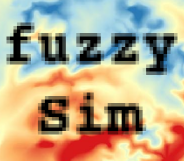
 |

fuzzySim is an R package for calculating fuzzy similarity in species occurrence patterns.
It includes functions for data preparation, such as converting species lists (long format) to presence-absence tables (wide format), obtaining unique abbreviations of species names, or transposing (parts of) complex data frames; and sample data sets for providing practical examples.
It can convert binary presence-absence to fuzzy occurrence data, using e.g. trend surface analysis, inverse distance interpolation or prevalence-independent environmental favourability modelling, for multiple species simultaneously.
It then calculates fuzzy similarity among (fuzzy) species distributions and/or among (fuzzy) regional species compositions. Currently available similarity indices are Jaccard, Sørensen, Simpson, and Baroni-Urbani & Buser.
To install a developing version (with the latest features and bug fix attempts) of fuzzySim from R-Forge, paste the following command in the R console (when connected to the internet):
install.packages("fuzzySim", repos="http://R-Forge.R-project.org")This should work if you have the latest version of R; otherwise, it may either fail (producing a message like "package 'fuzzySim' is not available for your R version") or install an older version of fuzzySim. To check the version that you have actually installed, type citation(package="fuzzySim"). To install the latest version of the package, you can either upgrade R or download the compressed fuzzySim package source files to your disk (.zip or .tar.gz available here) and then install the package from there, e.g. with R menu "Packages - Install packages from local zip files" (Windows), or "Packages & Data - Package installer, Packages repository - Local source package" (Mac), or "Tools - Install packages - Install from: Package Archive File" (RStudio).
You only need to install (each version of) the package once, but then every time you re-open R you need to load it by typing:
library(fuzzySim)You can then check out the package help files and try some of the provided examples:
help("fuzzySim")If you use fuzzySim in publications, please cite the following paper:
Barbosa A.M. (2015) fuzzySim: applying fuzzy logic to binary similarity indices in ecology. Methods in Ecology and Evolution, 6: 853-858 (DOI: 10.1111/2041-210X.12372)
To see how to cite the package itself, load it in R and type citation(package="fuzzySim").
A number of articles have already used or cited fuzzySim in diverse studies, from biogeography and evolutionary ecology to climatology or robotics -- here are just a few examples, excluding self-citations:
Aximoff I., Carvalho W.D., Romero D., Lustosa Esberard C.E., Guerrero L.M. & Rosalino L.M. (2020) Unravelling the drivers of maned wolf activity along an elevational gradient in the Atlantic Forest, south-eastern Brazil. Mamm Biol 100, 187-201. DOI: 10.1007/s42991-020-00017-x
Broeckhoven C., El Adak Y., Hui C., Van Damme R. & Stankowich T. (2018) On dangerous ground: the evolution of body armour in cordyline lizards. Proceedings of the Royal Society B: Biological Sciences/ 285(1880): 20180513. DOI: 10.1098/rspb.2018.0513
Caravaggi A., Leach K., Santilli F., Rintala J., Helle P., Tiainen J., Bisi F., Martinoli A., Montgomery W.I. & Reid N. (2017) Niche overlap of mountain hare subspecies and the vulnerability of their ranges to invasion by the European hare; the (bad) luck of the Irish. Biological Invasions, 19: 655-674. DOI: 10.1007/s10530-016-1330-z
Caraveo C., Valdez F. & Castillo O. (2017) A new meta-heuristics of optimization with dynamic adaptation of parameters using type-2 fuzzy logic for trajectory control of a mobile robot. Algorithms, 10(3): 85. DOI: 10.3390/a10030085
Coelho L., Romero D., Queirolo D. & Guerrero J.C. (2018) Understanding factors affecting the distribution of the maned wolf (Chrysocyon brachyurus) in South America: Spatial dynamics and environmental drivers. Mammalian Biology, 92: 54-61. DOI: 10.1016/j.mambio.2018.04.006
da Silva B.A., Guerrero J.C., Bidegaray-Batista L. & Simo M. (2020) Description of Latica, a new monotypic spider genus from Uruguay and Argentina (Araneae, Herpyllinae, Gnaphosidae): An integrative approach. Zoologischer Anzeiger, 288: 84-96. DOI: 10.1016/j.jcz.2020.07.006
Dick D.G. & Laflamme M. (2018) Fuzzy ecospace modelling. Methods in Ecology and Evolution, 9(6): 1442-1452. DOI: 10.1111/2041-210X.13010
Herkt K.M.B., Skidmore A.K., Fahr J. (2017) Macroecological conclusions based on IUCN expert maps: A call for caution. Global Ecology and Biogeography, 26: 930-941. DOI: 10.1111/geb.12601
Linero D., Cuervo-Robayo A.P. & Etter A. (2020) Assessing the future conservation potential of the Amazon and Andes Protected Areas: Using the woolly monkey (Lagothrix lagothricha) as an umbrella species. Journal for Nature Conservation, 58: 125926
Moreno‐Zarate L., Estrada A., Peach W. & Arroyo B. (2020) Spatial heterogeneity in population change of the globally threatened European turtle dove in Spain: The role of environmental favourability and land use. Diversity & Distributions, https://doi.org/10.1111/ddi.13067
Petrosyan V., Osipov F., Bobrov V., Dergunova N., Omelchenko A., Varshavskiy A., Danielyan F. & Arakelyan M. (2020) Species Distribution Models and Niche Partitioning among Unisexual Darevskia dahli and Its Parental Bisexual (D. portschinskii, D. mixta) Rock Lizards in the Caucasus. Mathematics, 8: 1329. DOI: 10.3390/math8081329
Romero D., Olivero J., Real R. & Guerrero J.C. (2019) Applying fuzzy logic to assess the biogeographical risk of dengue in South America. Parasites & Vectors, 12: 428. DOI: 10.1186/s13071-019-3691-5
Silva Mendes S., Antunes de Mello Affonso P.R., de Oliveira Alves R.M., Batalha-Filho H. & Waldschmidt A.M. (2020) Integrative approach untangles the misconceptions about the range and identity of two stingless bees from the Brazilian semiarid region. Journal of Apicultural Research, 59(4):592-59
Title, P.O. & Bemmels, J. (2018) ENVIREM: an expanded set of bioclimatic and topographic variables increases flexibility and improves performance of ecological niche modeling. Ecography, 41: 291-307. DOI:10.1111/ecog.02880
Here's a poster made to present fuzzySim at Rencontres R 2014, and a scientific paper presenting the package, though it has grown a lot since then.
Here's an illustrated beginners tutorial of the basics of fuzzySim. There's also a beginners tutorial on species distribution modelling with fuzzySim, and a (somewhat outdated) course manual on model building with fuzzySim and model evaluation with modEvA (in Spanish). There's also a short tutorial on rangemap comparison with fuzzySim.
Read the functions' help files for full documentation.Go here for further info on the package and its origins.
The R-Forge project summary page you can find here.